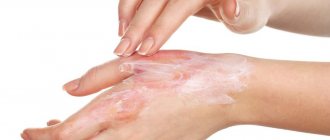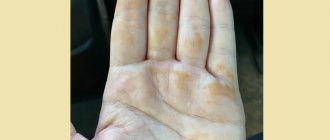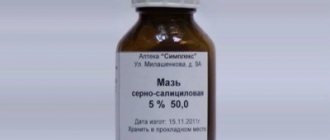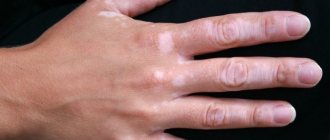Quite common nowadays are questions about why yellow spots appear on the human body and what they may indicate. That is why we will now try to understand this in more detail.
A person’s skin is considered a mirror of his health, because a considerable number of diseases and pathological processes are manifested by changes in his condition. Most often, various spots appear on the skin. In this case, it is recommended to seek help from a doctor as soon as possible, because only he can determine the exact cause of their appearance and prescribe adequate treatment.
Possible causes of age spots
Among the main reasons that cause the appearance of unsightly age spots on the face are the following:
- Hereditary predisposition. Such spots include, for example, nevi, which are formed due to the uneven formation and distribution of melanin in skin cells. Most often they are beige or brown in color. Every person has a certain number of congenital age spots. However, if they begin to enlarge, become injured, or there are too many of them, this can lead to the development of cancer, and therefore such spots must be removed in a timely manner.
- Exposure to ultraviolet rays. Prolonged and heavy sun exposure often leads to the formation of age spots, such as freckles. This is due to excess melanin production when exposed to ultraviolet rays. In this case, it is possible to avoid the appearance of age spots if you use protective creams before sunbathing. This is perhaps the only reason that you can eliminate on your own, although consulting a good cosmetologist in this case will not be superfluous. Currently, there are a lot of drugs that can eliminate or “whiten” such age spots very quickly.
- Use of low-quality cosmetics and perfumes . The appearance of age spots is associated with exposure to harmful components that are part of such products and directly affect the skin. Treatment will be required here.
- Folic acid deficiency . Occurs in the body during certain diseases of the circulatory and immune systems. As a result, skin changes are observed, which are manifested by the appearance of age spots. Folic acid may be insufficiently supplied from food and may be observed in folate deficiency anemia, pregnancy and a number of other conditions. A lack of vitamin C and copper in the body can also cause the appearance of age spots.
- Age-related skin changes . They appear after 50 years and are signs of age. These spots are called lentigo spots. They occur in areas that are most frequently exposed to ultraviolet radiation, namely the face and hands. Their occurrence is associated with biological changes occurring in the skin; menopause and increased estrogen levels cause an increase in the number of such spots.
- Hormonal changes . They are one of the most common causes of age spots.
Very often, so-called chloasma occurs on the face, abdomen and around the nipples and genitals of pregnant women. The formations are characterized by a very specific location. For example, on the face they are usually on the bridge of the nose, temples, chin or upper lip, forming the so-called pregnancy mask. The reason for their appearance is a change in the general hormonal background, which means changes in the content of estrogen and progesterone, which, while expecting a baby, are present in a woman’s body in a different proportion than at normal times.
Chloasma that appears during pregnancy tends to disappear on its own after childbirth. Accordingly, no special therapy is required in this case. But to try to avoid their appearance, you should spend less time in the sun, eat healthy and balanced, and do not experiment with cosmetics. You can lubricate your face and other dangerous areas with special creams with a high content of folic acid, which are available in a wide range today.
Hormonal imbalances are observed not only in pregnant women. Fluctuations in the level of progesterone and estrogen, which occur during the normal physiological cycle in women, can also cause age spots on the face. This is called melanosis, in the formation of which an increase in the level of estrogen plays a significant role, which stimulates the formation of melanin. More often, this problem is typical for brunettes whose skin belongs to the fourth phototype. The spots that form in this case are uneven in shape and are located on the forehead, temples, cheeks, in the area of the upper lip and above the upper lip.
Taking oral contraceptives , as well as topical estrogen, can also cause spots to appear. The appearance of chloasma is accompanied by the onset of menopause. The reason for their occurrence also lies in the level of estrogen and an increase in the synthesis of pigments.
Many serious diseases are also accompanied by an increase in the level of estrogen in the blood and, as a result, the formation of age spots on the face. This may include:
- thyroid diseases that affect hormonal levels in the body;
- ovarian cysts and tumors;
- panhypopituitarism;
- pituitary tumors accompanied by increased production of estrogen;
- pathology of the adrenal glands;
- stress;
- obesity (estrogens are produced by adipose tissue);
- some diseases of the liver and gall bladder.
It is quite difficult to deal with spots that arise due to hormonal disorders. Sometimes it is not enough to identify and eliminate the causes that led to their formation, and in some cases it is difficult to completely get rid of the disease itself. In such a situation, women often resort to the help of cosmetologists to cope with the problem. However, if the underlying cause continues to adversely affect the body, the spots will appear again.
- Features of metabolic processes . Metabolism in the body is very important. Some diseases lead to its disruption. As a result, excess melanin production occurs and pigment spots form. Gallstone disease, hepatitis A, diseases that lead to impaired absorption of vitamins and minerals in the intestines can also cause the formation of age spots.
- Nervous disorders . Stress is, although not the most common, one of the reasons for the appearance of age spots.
How to recognize breast diseases and keep your breasts healthy and beautiful
In pursuit of the external beauty of our breasts, we use many products to change the shape, increase volume and tighten the skin... But we often forget about the main thing - the breasts should be healthy!
Signs you should pay attention to and consult a doctor immediately
- Do not tolerate pain in the mammary glands! Pain is your body’s distress signal and its request for help!
- Any changes in the shape, symmetry or size of the mammary glands, changes in the configuration of the mammary glands (retracted areas or protrusions).
- Condition of the nipple and halos (deformation, ulcers, retracted areas).
- The presence of discharge from the nipple and halos, their nature (color, quantity).
- Condition of the skin of the mammary gland (redness, swelling, “lemon” peel).
- Expanded network of blood vessels
- The presence of nodular seals, painful areas.
- Enlargement, hardening or tenderness of the axillary and lymph nodes.
How to recognize breast diseases and keep your breasts healthy and beautiful?
Answer a few simple questions:
- Every month, a few days before your period, do you feel that your breasts are swollen, swollen, and painful?
- Can you feel lumps of different sizes in the mammary glands?
- Do you experience nipple discharge when pressure is applied?
- Are you taking birth control pills?
- Are you taking menopausal or hormone replacement therapy?
- Do you experience constant nagging pain in the mammary glands?
- Are you overweight, have diabetes, or have thyroid disease?
- How long have you been smoking?
- Have any of your close relatives had any cases of breast, uterine or ovarian cancer?
- Have you had a late first birth (after 30 years of age) or have you had an abortion or postpartum mastitis?
- Have you had breast surgery?
If you answered “YES” to at least one question, you need a consultation with a mammologist.
Risk factors for breast cancer:
- first pregnancy over 30 years of age;
- body mass index more than 30 kg/m2, after menopause (insulin resistance);
- menarche up to 12 years;
- alcohol abuse;
- high intake of saturated fat;
- late menopause;
- the woman has a family history of breast cancer;
- carriage of the BRCA1 and BRCA2 genes
We regularly brush our teeth, go for manicures and pedicures, cut our hair, do makeup - and all these are common hygiene procedures for most women. So why does breast self-examination hygiene remain something unnecessary for most women?
Regular examination is a reliable method of preventing breast cancer, especially in women with recurrent breast pain!
Methods for diagnosing breast diseases:
- 1. Self-examination of the mammary glands once a month.
- 2. Examination by a gynecologist at least once a year.
- Ultrasound of the mammary glands is most informative in women under 35 years of age at least once a year. The advantages of the method are as follows :
- safety in terms of dose load;
- no age restrictions;
- high resolution;
- assessment of the condition of silicone breast implants;
- examination of the mammary glands during the acute period of severe mastalgia, injury or inflammation;
- visualization of regional lymph nodes;
- conducting targeted puncture biopsies under objective visual control of palpable and non-palpable formations in the mammary gland;
- pregnant and lactating women;
- examination of children and adolescents;
- dynamic control during treatment;
- monitoring of benign tumors.
- Mammography is an X-ray examination of breast tissue that can detect tumors before they can be felt by palpation. Recommended for all women over 40 years old once a year; for women from 35 to 40 years old, it is performed in case of tumor-like changes during objective ultrasound and other studies. Mammography is necessary before plastic surgery or prescribing hormonal therapy. Mammograms are performed in the first phase of the menstrual cycle (from 5 to 12 days, counting from the first day of menstruation); For menopausal women, images can be taken at any time.
- Biopsy with cytological or histological examination - obtaining, under ultrasound control, a small number of cells or a piece of tumor for examination under a microscope (as indicated).
- Determination of tumor markers (Ca15-3, CEA) are substances that a tumor releases into the human blood. At the same time, the most significant increase in these indicators is observed in malignant diseases, which allows the use of tumor markers, firstly, for early diagnosis of cancer, and secondly, for monitoring ongoing antitumor therapy and early detection of metastases. However, a slight increase in the level of tumor markers in the blood is possible with benign processes and inflammatory diseases of organs. Therefore, the detection of elevated levels of one or another tumor marker is not a basis for diagnosing cancer , but serves as a reason for an in-depth examination of the patient.
- Determination of susceptibility genes BRCA1 and BRCA2
Conducted studies suggest that mutations of these genes are responsible for 30-40% of hereditary predisposition to breast cancer.
OKDC has all the listed modern and relevant methods for diagnosing the condition of the mammary glands.
Breast self-examination
Self-examination should be carried out on the 5-7th day after menstruation or on the same day every month if there is no menstruation.
If you notice any external changes to your breasts or changes in sensation in the breast area, consult your doctor immediately.
Please note that with each passing month, self-examination will become an increasingly simple and familiar procedure for you.
6 Easy Steps to Perform a Breast Exam
(it’s best to do this while standing in the bathroom with soapy hands)
Step 1
Self-examination begins with examining the mammary glands in front of a mirror. Stand up straight, lower your arms along your body. Carefully examine the mammary glands, paying attention to changes in the volume and shape of the breast, as well as changes in the color of the skin, nipple and areola.
Step 2
Raise your hands behind your head. Examine the mammary glands in this position: their shape, the presence of retractions or bulges. Make sure there are no areas of lemon peel or discoloration on the skin. The shape and size of the mammary glands may differ slightly from each other, this is not a sign of a disease, but if these differences suddenly appear or increase, you need to consult a doctor
Step 3
Lightly squeeze the nipple with the thumb and index finger of your opposite hand. Check to see if there is any discharge from the nipple. If there is discharge, be sure to pay attention to its color.
Step 4
Raise your right arm and throw it behind your head. Using the pads of three or four fingers of your left hand, in a circular motion, slowly palpate your right breast.
For a more thorough examination, divide the mammary gland into 4 parts (quadrants) and conduct the examination sequentially - quadrant by quadrant. Repeat the same with the left breast (mirror).
Step 5
Examine the mammary glands in quadrants while lying down. This will allow a more thorough examination of the lower areas of the mammary gland.
Step 6
Feel the armpit and try to locate the axillary lymph nodes. If they have recently become palpable or their shape has changed, then pay attention to this and tell your gynecologist about your observations.
share information
0
Social buttons for Joomla
Treatment
Age spots are not an independent disease, but a symptom. Therefore, before treating pigment spots that have arisen, it is necessary to find out the cause of their formation, and for this you will have to undergo examination by a gynecologist, endocrinologist, gastroenterologist and neurologist. Treatment begins with treating the underlying disease, and only then does it make sense to begin to discolor spots and eliminate skin defects.
Among the methods for eliminating age spots, the following are currently widely used:
- laser removal. This is one of the most effective and harmless ways to get rid of age spots.
- chemical peeling, which is effective only on superficial stains;
- photoremoval (photorejuvenation);
The treatment option must be determined by the doctor, since only a specialist can, taking into account the characteristics of the skin and the condition of the patient’s body, identify all possible contraindications.
Find out the cost
Reasons for formation
Yellow spots on the skin can appear as a result of various pathological conditions in the human body, which is what we will talk about now.
Hemorrhage
Hemorrhage is a hemorrhage that is formed as a result of a violation of the integrity of blood vessels. The tissues become saturated with blood, which provokes the appearance of red spots on the skin, which change color over time and become yellow.
Diseases of dermatological origin
This could be lichen, urticaria and other diseases. Their main symptom is the formation of yellowish spots. In most cases, young children suffer from these pathological conditions, but their occurrence in adults is no exception.
Children develop pink spots that fill with exudate over time. After healing, yellow-brown marks remain on the skin. In adults, yellow spots appear on the face, arms, stomach and spread throughout the body, their diameter reaches 5 mm.
Please note that diseases can develop as a result of:
- mechanical irritation of the skin,
- influence of ultraviolet radiation,
- use of medications,
- influence of cold,
- psychological overload,
- consumption of certain foods.
Orange spots on the skin may be a symptom. both the systemic form of the disease (when internal organs are damaged) and the skin form.
Systemic diseases
Changes in the skin can appear with Addison's disease, lupus erythematosus, and diabetes mellitus.
Course of poikiloderma
The course is slow, but progressive and irreversible.
The beginning is the appearance of age spots, a peculiarity: the spots have a mesh pattern due to telangiectasia. The spots gradually merge, forming conglomerates. Gradually, nodular rashes form on the spots.
A little later, as the process progresses, areas of skin atrophy appear.
Possible general malaise: weakness, headache and loss of appetite.
Any disease is easier to prevent than to treat. This also applies to pigmentation. Therefore, take preventative measures to avoid cosmetic defects.
Cosmetologists advise: in the summer, when the sun is in its active phase, stay more in the shade, wear light clothes, lubricate the skin with creams with a high level of sun protection. Wear sunglasses and hats, and if pigmentation does appear, get a blood test and get a liver test.
In general, there are several ways to combat age spots. This includes proper nutrition, procedures in beauty salons, folk recipes and specialized remedies for age spots on the hands.
Proper nutrition
A proper diet is the basis for treating pigmentation. A balanced diet saturates the body with vitamins and useful minerals. The diet should contain more fruits, vegetables, lean meat, fish, and dairy products.
Avoid fried and fatty foods, which strain the liver. The health, color, and tone of the skin completely depend on the proper functioning of the liver.
Procedures in beauty salons
Noticed hyperpigmentation on your hands? Make an appointment at a beauty salon with a qualified cosmetologist. Several types of procedures are performed here to get rid of skin defects. This:
- Dermabrasion is superficial resurfacing of pigmented areas. These are removed, revealing healthy layers of skin. The epidermis is renewed, becomes smooth, beautiful, and light. The result will be noticeable after 2-3 sessions.
- Chemical peeling is the removal of stains using chemical compounds. The final result will become noticeable a week later, after the skin is cleansed and renewed.
- Cryotherapy is the effect of liquid nitrogen on pigmentation. The tissue freezes, dies and is rejected. The spots disappear along with them.
- Laser removal – destruction of melanin by laser beams. The radiation affects the affected areas and does not affect surrounding tissues. Before the session, a colorless gel is applied to the skin to ensure close contact with the emitter. The number of sessions depends on the severity of the defect. If the pigmentation is in the deep layers and the spots are large, several manipulations will be needed. After each session, you need a break for a month to allow the skin to rest.
Salon methods show good results and allow you to get rid of age spots on your hands in a short period of time. The result will last for a long time, but provided that you stop exposure to the factors that caused the problem.
Cosmetical tools
There is a large selection of remedies for age spots on the hands. Some of them have a pronounced effect, others are less effective. Below are the most popular anti-pigmentation creams that have earned the best consumer reviews:
- SkinCeuticals Phloretin CF Gel. Contains phloretin, ferulic acid, vitamin C. The components of the drug reduce cell damage caused by ultraviolet radiation, activate collagen production, increase skin elasticity and tone.
- Serum Kiehl's, Clearly Corrective Dark Spot Solution. Helps remove hyperpigmentation caused by photodamage or other factors. Contains vitamin C, peony and birch extract. Evens out skin tone and makes it radiant. Good prevention against hyperpigmentation in the future.
- Cream Garnier Ambre Solaire “Expert Protection”, SPF 50. Contains vitamin E. High sun protection factor. The cream prevents photoaging and hyperpigmentation.
- Hand cream that eliminates pigmentation on hands, South Beach Skin Solutions (USA). A very effective remedy for pigmentation. Complete skin lightening in just 10 days, with a 100% guarantee of effect. The result is noticeable after the first use. The spots become lighter with each procedure, and then disappear completely. It brightens not only the hands, but also other areas of the body. Effectively copes even with freckles. Contains natural ingredients and is therefore safe for health. Not only brightens the skin, but also makes it more elastic, youthful, and radiant.
In general, the effect of masks and creams for whitening age spots is based on the ability of the components included in the preparations to destroy melanin. Interestingly, the main component that destroys pigment is hydroquinone. But hydroquinone is a carcinogen and is not suitable for everyone. Therefore, you need to be extremely careful when choosing funds. By the way, the last cream from our rating, South Beach Skin Solutions (USA), does not contain hydroquinone! It qualitatively brightens due to other components: zinc oxide, glycerin, emulsifying wax and plant components with a whitening effect.
Please note that medications may even contain mercury. It is cheap and is often added to cosmetic products for whitening. So be careful.
Cosmetologists advise choosing masks and creams with plant extracts and natural ingredients. They are safe and effective in treating age spots on the hands of any severity.
Folk recipes
If you can’t afford a hand cream that gets rid of pigmentation on your hands, as well as expensive procedures in beauty salons, you can try folk remedies. Help to whiten hyperpigmentation:
- lemon juice;
- fresh cucumber;
- White clay;
- kefir.
There are many recipes using the listed ingredients to help lighten hyperpigmentation. You need to do the procedures regularly, then the effect will be noticeable.
Recipes for removing age spots:
- Take ½ teaspoon each of clay, baking soda, talcum powder. Mix the ingredients, add 3% hydrogen peroxide. The mixture should resemble thick sour cream in consistency. Apply the composition, leave for 5-10 minutes, rinse.
- Dilute hydrogen peroxide 3% in a 1 to 1 ratio with water. Moisten the skin with a cotton swab. Repeat the procedure once a week.
- Sauerkraut juice and white clay should be mixed and applied for 15 minutes. Then wash off.
- Mix 25 drops of peroxide, 25 drops of ammonia with two tbsp. l. sour cream. Lubricate the stains with the mixture, wrap with plastic wrap and a towel on top. Leave on for 25 minutes, then rinse off.
- Take one part vinegar 9%, one part vodka and half part peroxide. Mix the ingredients, add the juice of one lemon. Pour the resulting lotion into a dark glass container. Use twice daily. Apply for 10 minutes, then rinse and apply moisturizer.
You need to take care of your skin regularly. You must not neglect pigmentation, otherwise it will be difficult to remove stains.
Folk recipes
Pharmaceutical and cosmetic products are multi-component, so one person may react normally to them, while another will have an allergic reaction. Be sure to conduct a sensitivity test before applying a specific drug. It's simple: apply the cream to the inside of your wrist, wait 20 minutes. If there is no rash or redness, the product can be used.
After using whitening creams, you need to stay at home for 1-2 hours, since cleansing the skin causes a reaction to ultraviolet radiation, and exposure to sunlight can cause a burn. If the cream does not contain sun protection, supplement your care with SPF.
Cosmetics or procedures in salons are used only after consultation with a doctor - remember this. The dermatologist will give recommendations on products and cosmetic procedures that are suitable for you, and determine the cause of hyperpigmentation. And don’t forget that the disease is easier to prevent, so don’t neglect prevention.
Causes
The etiology of the disease has not yet been identified, the exact cause is unknown.
Scientists were able to find out a number of factors that provoke the occurrence of Siwatt’s poikiloderma:
- UV rays - prolonged and regular exposure to ultraviolet radiation leads to the formation of solar elastosis in the dermis, hyperkeratosis and atrophy of the epidermis.
- Hormonal factors - occurs more often in fair-skinned women during the postmenopausal period.
- Allergens are agents that can cause allergies, intoxication and poisoning of the body. In particular, it is often provoked by wearing chains containing nickel or other alloys.
Remedies
When diagnosing xanthomas, first of all, you need to monitor your diet. It is recommended to avoid drinking alcoholic beverages, dishes and foods containing large amounts of animal fats. Particular attention should be paid to the level of cholesterol in the blood; if it increases, it is recommended to take medications prescribed by the doctor.
If the xanthomas are large and cause a cosmetic defect, they may need to be removed. This can be done using:
- electrocoagulation,
- laser,
- surgical intervention.
For treatment to be effective, it is necessary to determine the root cause of xanthomas and eliminate it. After this, they can disappear on their own without outside help.










